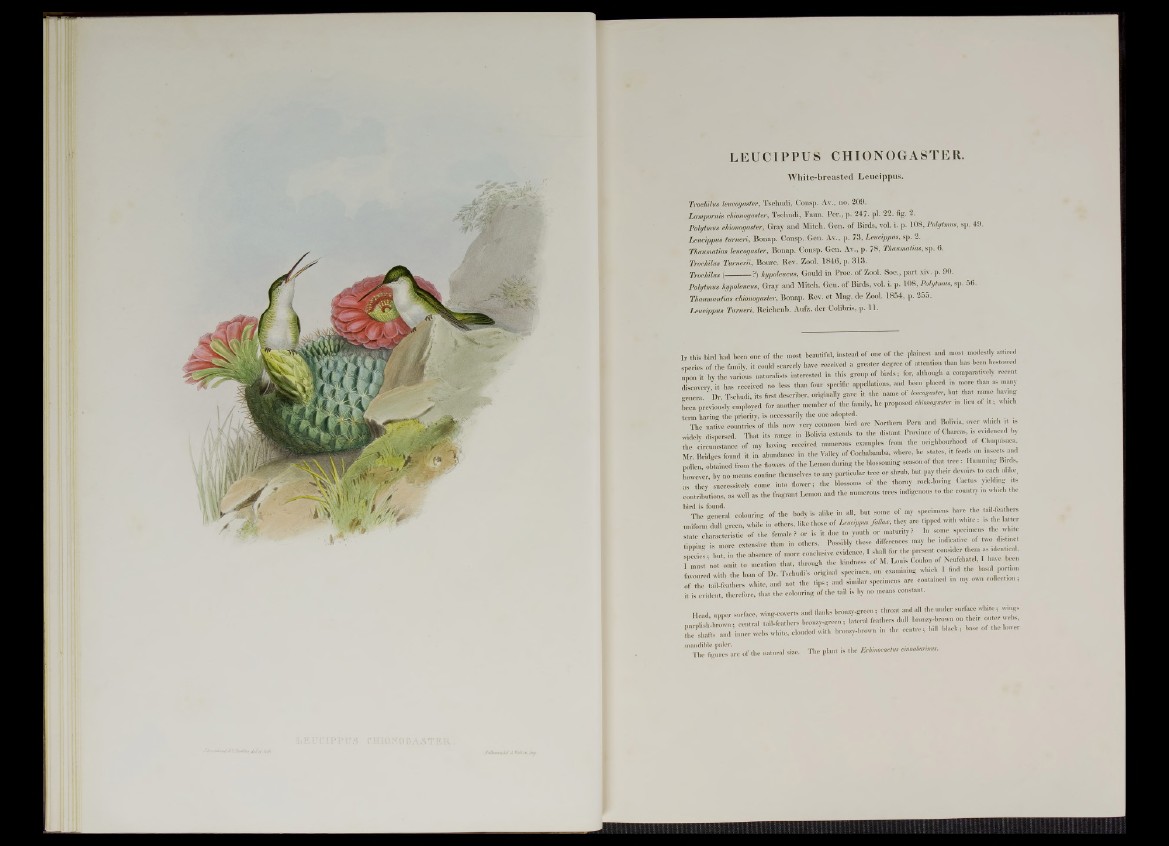
LEUCIPPUS CH10 NOG ASTER.
White-breasted Leucippus.
Trochilm leucogaster, Tscliudi, Consp. Ay., no. 209.
Lampornis chionogaster, Tscliudi, Faun. Per., p. 247. pi. 22. fig. 2.
Polytmm chionogaster, Gray and Mitch. Gen. o f Birds, vol. i. p. 108, Polytmm, sp. 49.
Leucippus truimen, Bonap. Consp. Gen. Av., p. 73, Leucippus, sp. 2.
Thaumatias Imcogaster, Bonap. Consp. Gen. Av., p. 78, Thaumatias, sp. 6.
Trochilm Turnerii, Bourc. B-ev. Zool. 1846, p. 313.
Trochilm (_______ ?) hypoleucm, Gould in Proc. o f Zool. Soc., part xiv. p. 90.
Polytmm hypoleucm, Gray and Mitch. Gen. of Birds, vol. i. p. 108, Polytmm, sp. 56.
Thawmantms chionogaster, Bonap. Rev. et Mag. de Zool. 1854, p. 255.
Leucippus Tumeri, Reichenb. Aufz. der Colibris, p. 11.
Ir this bird had been one of the most beautiful, instead of one of the plainest and most modestly attired
species of the family, it could scarcely have received a greater degree of attention than has been bestowed
upon it by the various naturalists interested in this gronp of birds; for, although a comparatively recent
discovery, it has received no less than four specific appellations, and been placed in more than as many
genera Dr Tschndi, its first describer, originally gave it the name of leucogaster, hot that name having
been previously employed for another member of the family, he proposed chionogaster m hen of it; which
term having the priority, is necessarily the one adopted. , „ . H H H
The native countries of this now very common bird are Northern Peru and Bolivia, oyer which it is
widely dispersed. That its range in Bolivia extends to the distant Province of Charcas, is evidenced by
the circumstance of m, having received numerous examples from the neighbourhood of Chuqmsaca
Mr. Bridges found it in abundance in the Valley of Cochabamba, where, he states, it feeds on insects and
pollen, obtained from the flowers of the Lemon during the blossoming season of that tre e: Humming Birds,
however, by no means confine themselves to any particnlar tree or shrub, but pay their devoirs to each alike,
as they successively come into flower; the blossoms of the thorny rock-loving Cactus yielding its
contributions, as well as the fragrant Lemon and the numerous trees indigenous to the country m which the
b lThe general colouring of the body is alike in all, but some of my specimens have the tail-feathers
uniform dull green, while in others, like those of Leucippus faUax, they are tipped with white •. is the latter
state characteristic of the female? or is it due to youth or maturity? In some specimens the w
tipping is more extensive than in others. Possibly these differences may be indicative of two distinct
s p e c ie s • hut in the absence of more conclusive evidence, I shall for the present consider them as identical.
I must’not omit to mention that, through the kindness of M. Louis Coulon of Nenfchatel, I have been
favoured with the loan of Dr. Tschudi's original specimen, on examining which I find the basal portion
of the tail-feathers white, and not the tips; and similar specimens are contained m my own collection;
it is evident, therefore, that the colouring of the tail is by no means constant.
o 0,„i b , hronzv-oreen: throat and all Hpad mmer surface, wing-coverts and flanks Dronzy-greeu, the under surface white; wings
Head, upper sur > S feathers dull bronzy-brown on their outer webs, r “ 3 \nr“ - - — « — - °f—
mandible paler. . , ■
The figures are of the natural site. The plant is the Echmcactus cnnaianms.